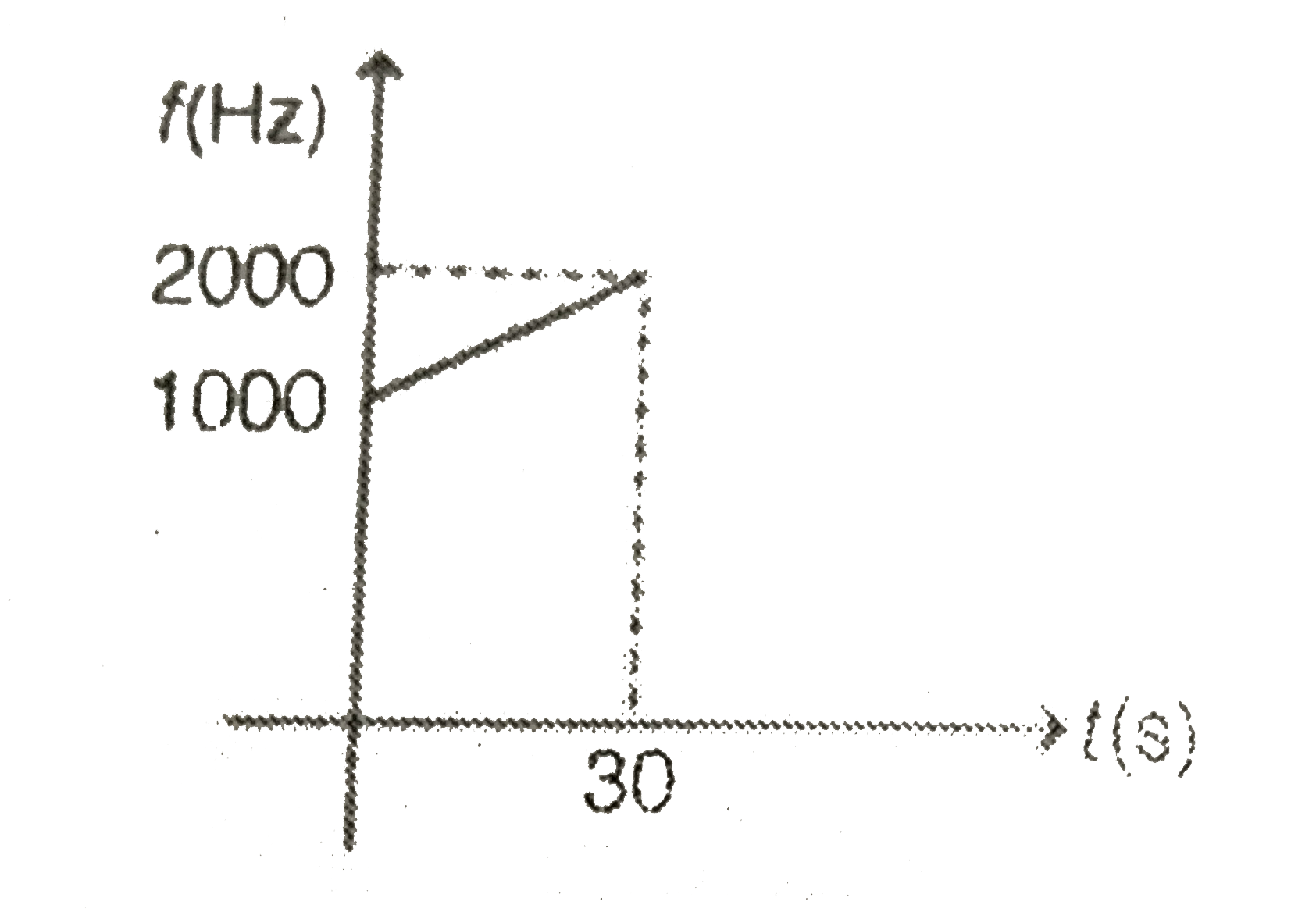A source of sound is moving along a circular orbit of radius 3 m with an angular velocity of 10 rad/s. A sound detector located far away from the source is executing linear simple harmonic motion along the line BD (see figure) with an amplitude BC = CD = 6m
The frequency of oscillation of the detector is 5π per second.
The source is at the point A when the detector is at the point B. If the source emits a continuous sound wave of frequency 340 Hz, find the maximum and the minimum frequencies recorded by the detector. (Speed of sound - 340 m/s)
_E01_133_Q01.png) .
.
The speed of sound in air =340m/s
r=3m, ω=10rad/s. The linear speed of the source along the circular orbit is
vs−rω=3×10m/s
The detector is executing SHM of amplitude a=6m and frequency n=5/πHz. The angular velocity of the detector is
ω'=2πn=2π×5/π=10rad/s
and the linear velocity of the detector is
u0=aω'=6×10=60m/s
Since the source and the detector have the same angular velocity (i.e. ω=ω'), they have the same time period T. At time t=T/4, the source will be at point P and the detector will be at point C.
Since they are receding from each other at the maximum relative velocity, the recorded frequency will be minimum which is given by
nmin=n(v−u0v+us)=340×(340−60340+30)=257Hz
At a time t=3T/4, the source will be at point Q and the detector will be at point C approaching the source with the maximum relative. Hence the recorded frequency will be maximum which is given by
nmax=n(v+u0v−us)=340×(340+60340−30)=485.7Hz


Topper's Solved these Questions
Similar Questions
A source of sound is moving along a circular orbit of radius 3meter with an angular velocity of 10rad/s. A sound detector located far away from the source is executing linear simple harmonic motion along the line BD with an amplitude BC=CD=6meters. The frequency of oscillation of the detector is 5π per second. The source is at the point A when the detector is at the point B. If the source emits a continuous sound wave of frequency 340Hz, Find the maximum and the minimum frequencies recorded by the detector.

View SolutionA source of sound is moving along a circular orbit of radius 3 m with an angular velocity of 10 rad/s. A sound detector located far away from the source is executing linear S.H.M. along the line BD (see Fig. 14.4.13) with an amplitude BC = CD=6m. The frequency of oscillation of the detector is 5/π per second. The source is at the point BA when the detector is at the point B. If the source epiits a continuous sound wave of frequency 340 Hz, find the maximum and the minimum frequencies recorded by the detector.

View SolutionA source of sound emitting a frequency 660 Hz is moving counter-clockwise in a circular path of radius 2 metres with an angular velocity 15 rad/s. A recorder at a distance from the source is moving simple harmonically along a straight line with an amplitude 2 metres. The frequency of SHM is 152π per second. The arrangement is shown in figure. When the source is at point A the detector is at D. Find the maximum and minimum frequencies recorded. Velocity of sound in air at this temperature can be taken as 300 m/s

View SolutionA source and a detector move away from each other, each with a speed of 10 m/s with respect to ground with no wind. If the detector detects a frequency 1650 Hz of the sound coming from the source, what is the original frequency of the source? (speed of sound = 340 m/s
View SolutionA source is moving with a constant speed of 10 m/s on a circular track of 200 m. It emits a sound of frequency 200 Hz. A listener stands at the centre of the circular track. The frequency received by the listener is (velocity of sound = 340 m/s)
View SolutionA source and a detector move away from each other, each with a speed of 10ms−1 with respect to the ground with no wind. If the detector detects a frequency 1950 Hz of the sound coming from the source, what is the original frequency of the source? Speed of sound in air =340ms−1.
View SolutionA detector is released from rest over a source of sound of frequency f0=103Hz. The frequency observed by the detector at time t is plotted in the graph. The speed of sound in air is (g=10m/s2)

View Solution
A source of sound and detector are moving as shown in Fig. at t=0. Take velocity of sound wave to be v. For this situation mark out the correct statement(s).
View Solution
A source of sound and detector are moving as shown in Fig. at t=0. Take velocity of sound wave to be v. For this situation mark out the correct statement(s).
View Solutionif the speed of a sound source is equal to the speed fo sound and the source is moving away from the observer, then the ratio of apparent frequency to the original frequency is
View Solution
